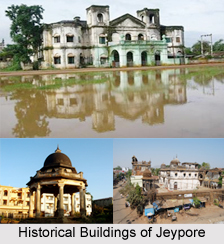 History of Jeypore clarifies itself as an ancient town with a niche in the history of Odisha. Jeypore is surrounded by forests with mostly Sal and teak trees. The town was the capital of the local king in the olden times and is known for its ancient forts, palaces and temples. The major languages spoken in this region are Odiya and a few indigenous languages. There is a diverse cultural mix of adivasi people and mainstream people of Odia ethnicity.
History of Jeypore clarifies itself as an ancient town with a niche in the history of Odisha. Jeypore is surrounded by forests with mostly Sal and teak trees. The town was the capital of the local king in the olden times and is known for its ancient forts, palaces and temples. The major languages spoken in this region are Odiya and a few indigenous languages. There is a diverse cultural mix of adivasi people and mainstream people of Odia ethnicity.
Location of Jeypore
Jeypore is situated at the middle of the south-west horn of Odisha. It is an amalgamation of the culture and traditions of the East and the South of India. This blend of different languages and cultures gives Jeypore its unique cuisine, language and lifestyle.
Forest Region of Jeypore
Jeypore is the most important place in the history of Dandakaranya and the undivided Koraput district which was the second largest district in India till its division. The history of Jeypore is inextricably linked with that of the ruling Deo or Dev dynasty.
Early History of Jeypore
Jeypore was for very long period of time, the capital of the kingdom of Koraput, which was ruled by the Atavikas, a feudatory of the powerful Kalinga Empire who are known for having valiantly fought the Kalinga War in the 3rd century BCE. Kalinga regained its former glory during the Mahameghabahan Dynasty in the first century BC. The third king of this dynasty, Kharavela made the Kalinga Empire and the Atavika land was very strong under his rule. The inscriptions of Podagarh refer to King Skanda Varma. The overlord Nala kings are traced to the kings who ruled from Gwalior in Madhya Pradesh. Their rapid growth landed them in the Odia regions of Bastar and Koraput. Around the 10th century CE a Nala king Bhimesen was ruling over a region now located in Koraput District and Ganjam District.
Medieval History of Jeypore
The Matsya family ruling over the Oddadi region of modern Jeypore dominated the next generation. The best known kings included Bhanudeva and Narasingha Dev, as is known from the Oriya inscription of Simhachalam in Visakhapatnam district of Andhra Pradesh. The next dynasty was that of the Sailavansis, who ruled over Vindhya during the 14th century CE. The earliest king, Ganga Raju, ruled over Nandapur, a former capital of the Maharaja of Jeypore. Nandapur is famous for the throne of 32 steps or Singhasan Batisi erected in the line of king Vikramaditya of Ujjain. Jainism and Shaktism grew side by side in the kingdom of Nandapur.
Modern History of Jeypore
During the Anglo-French conflict, Vikram Dev I (1758-1781 CE) was successful in driving out the French East India Company from Malkangiri area and the Marathas from the Umerkote belt. He was succeeded by the brave Oriya king Ramachandra Dev II (1781-1825) while his other two sons Jagannath and Narasingh Dev were placed in charge of Nabarangpur and Gudari regions. Jagannath Dev"s son Arjun Dev and Narasingha Dev"s son Chaitanya Dev were issueless. Hence, Nabarangpur and Gudari were remerged to Jeypore kingdom. During the 20th century Ramachandra Dev IV (1920-31) was an honourable lieutenant in World War I. He was issueless and was succeeded by a benevolent, aged, scholar king Vikram Dev IV, the son of Krishna Chandra Dev. During this period the Boundary Commission headed by Sir O"Donnel was entrusted with the task of writing the different Oriya speaking tracts. The Commission went round Jeypore, Paralakhemundi, Ganjam, and Visakhapatnam before finalizing its decision. The state of Odisha was formed on 1st April 1936 with Koraput as one of the six districts.
Related Articles
Cities of Orissa
Jeypore
Odisha, Indian state
Daringibadi, Kandhmal district, Odisha
Temples of Odisha



















